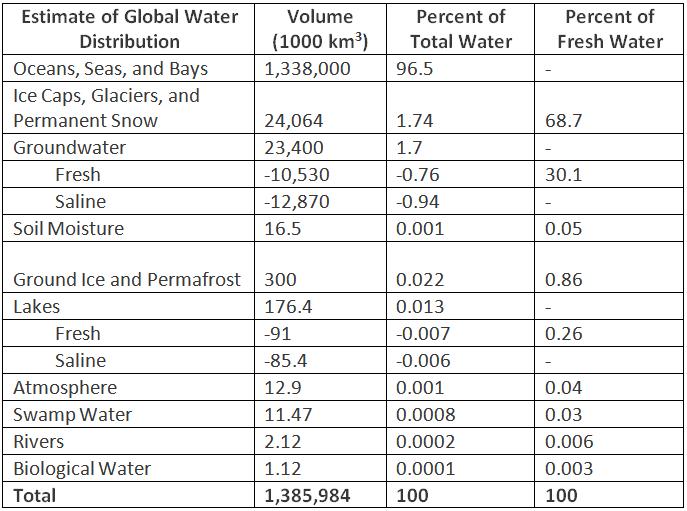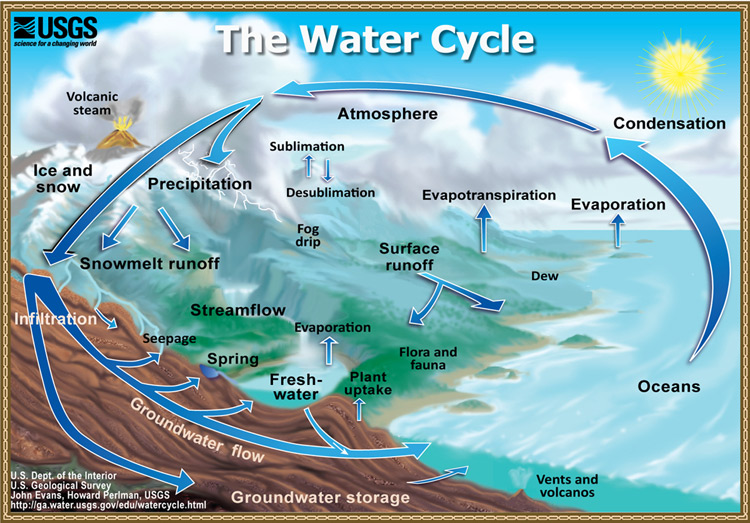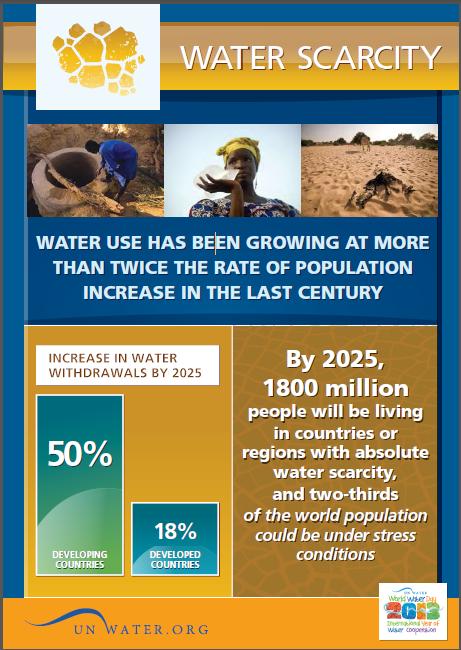It seems almost ironic that people must deal with water shortage and water stress, given that 70% of Earth’s surface is comprised of oceans, some of which reach depths of more than six km (close to 4 miles), yet that is one of the biggest concerns the world is now facing.
Global water availability is summarized in the table below:
 The oceans hold almost all of Earth’s water. Ocean water is a solution of various salts; most abundantly, what we call common salt. The most common unit used to expresses the salinity of water is Parts Per Thousands (ppt), which measures the number of grams of salts in one kg of solution. For example, the salinity of ocean water ranges between 30 – 50 ppt, while fresh water is defined as having a salinity of less than 0.5 ppt. For drinking and agriculture we need fresh water, yet most of that is stored in the form of ice caps, glaciers and permanent snow. The only parts of these resources available for human consumption are those that melt and feed ground water, lakes and rivers.
The oceans hold almost all of Earth’s water. Ocean water is a solution of various salts; most abundantly, what we call common salt. The most common unit used to expresses the salinity of water is Parts Per Thousands (ppt), which measures the number of grams of salts in one kg of solution. For example, the salinity of ocean water ranges between 30 – 50 ppt, while fresh water is defined as having a salinity of less than 0.5 ppt. For drinking and agriculture we need fresh water, yet most of that is stored in the form of ice caps, glaciers and permanent snow. The only parts of these resources available for human consumption are those that melt and feed ground water, lakes and rivers.
Water journeys from sea to land to the atmosphere by way of the water cycle. A schematic representation from the United States Geological Service (USGS), one of the US government agencies charged with monitoring this flow, is shown below: .
 The cycle is driven by solar energy, which powers the evaporation of water from the oceans and drives the vapor into the atmosphere against the gravitational field. It also describes the various ways in which water returns to the ocean. In a perfect cycle, there would be no gain or loss of water; the same amount of water that evaporated would eventually return. This cycle is not completely perfect, especially if we measure the water over a short time period. Precipitation in the form of snow which stays in the form of ice caps for thousands of years will show up back in the ocean only when the snow and ice melt. In addition, a “small” amount of ocean water penetrates the relatively thin crust at the bottom of the oceans to interact with the magma. These deviations from a perfect cycle are relatively small, especially if measured over a long time.
The cycle is driven by solar energy, which powers the evaporation of water from the oceans and drives the vapor into the atmosphere against the gravitational field. It also describes the various ways in which water returns to the ocean. In a perfect cycle, there would be no gain or loss of water; the same amount of water that evaporated would eventually return. This cycle is not completely perfect, especially if we measure the water over a short time period. Precipitation in the form of snow which stays in the form of ice caps for thousands of years will show up back in the ocean only when the snow and ice melt. In addition, a “small” amount of ocean water penetrates the relatively thin crust at the bottom of the oceans to interact with the magma. These deviations from a perfect cycle are relatively small, especially if measured over a long time.
The water that evaporates from the ocean is “fresh” water. It reacquires its salt content through its journey back to the ocean. Almost all of the processes in the Water Cycle are driven by evaporation and condensation. Since the oceans make up 70% of Earth’s surface, most of the precipitation falls directly back into them. Only about 10% finds its way to land through the weather system. The water cycle is almost a perfect cycle, but only when viewed globally and over a sufficiently long time. Individual places on earth do not make up their own full cycles. We have had countless droughts and floods throughout history.
Climate change is causing an increase in global temperature. Since the rate of evaporation increases with temperature, the rate of evaporation from the ocean should increase with climate change. However, the rate of evaporation from land and plant transpiration will also increase, requiring even more fresh water to accommodate the loss. The net effect is that while climate change has a pronounced effect on the intensity of the water cycle (as can be measured through the rates of evaporation or global precipitation), it cannot cause global water shortage.
That being said, droughts, floods, extreme storms, sea level rise, salination of ground water, etc… represent indications of the main impacts of climate change. These impacts are being amplified by the simple, mostly regional, overuse of fresh water – caused by both an increasing population and an ongoing increase in the standard of living.
The situation is best summarized by the United Nations poster shown below:
 Fresh water is not a luxury good that we can substitute with alternatives. We can manage it more effectively, but management in areas like South Saharan Africa and the Southwestern United States might require different strategies. In future blogs I will try to make the case that the most promising strategies should involve collective management of both global energy and water usage. To be successful in mitigation and adaptation to climate change, the management of both water and energy must become a coordinated effort.
Fresh water is not a luxury good that we can substitute with alternatives. We can manage it more effectively, but management in areas like South Saharan Africa and the Southwestern United States might require different strategies. In future blogs I will try to make the case that the most promising strategies should involve collective management of both global energy and water usage. To be successful in mitigation and adaptation to climate change, the management of both water and energy must become a coordinated effort.

Thank you for sharing this fantastic blog….! read our blog from
Digital Dopamine
Food is an important part of our daily lives; it gives us energy, nutrients, and satisfaction. But can we value it beyond its role in our bodily mechanisms
Thank you for information.
I blog frequently and I truly appreciate your information.
This article has truly peaked my interest. I am going to bookmark your website
and keep checking for new details about once a week. I opted in
for your Feed too.
Dr. Tomkiewicz, I’d like to publish your blog on water in Our Time Press, an 18-year-old weekly paper serving the African-American community in Brooklyn. See us at http://www.ourtimepress.com.
I just saw your blog and we go to press tomorrow, so please let me know soonest. Of course we’ll include the About climatechangefork